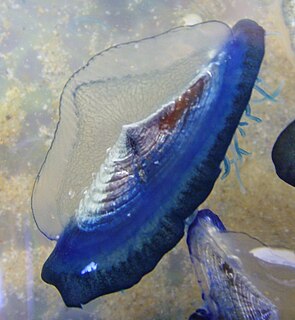
Velella is a monospecific genus of hydrozoa in the Porpitidae family. Its only known species is Velella velella, a cosmopolitan free-floating hydrozoan that lives on the surface of the open ocean. It is commonly known by the names sea raft, by-the-wind sailor, purple sail, little sail, or simply Velella.

Turritopsis dohrnii, also known as the immortal jellyfish, is a species of small, biologically immortal jellyfish found worldwide in temperate to tropic waters. It is one of the few known cases of animals capable of reverting completely to a sexually immature, colonial stage after having reached sexual maturity as a solitary individual. Others include the jellyfish Laodicea undulata and species of the genus Aurelia.

The Arctic realm is one of the planet's twelve marine realms, as designated by the WWF and Nature Conservancy. It includes the coastal regions and continental shelves of the Arctic Ocean and adjacent seas, including the Arctic Archipelago, Hudson Bay, and the Labrador Sea of northern Canada, the seas surrounding Greenland, the northern and eastern coasts of Iceland, and the eastern Bering Sea.

Facelina annulicornis is a species of sea slugs, an aeolid nudibranch, a marine gastropod mollusc in the family Facelinidae.

Tubularia indivisa, or oaten pipes hydroid, is a species of large hydroid native to the northeastern Atlantic Ocean, the North Sea, Norwegian Sea, and the English Channel. The conical solitary polyps are found on dull yellow unbranched stems that reach 10 to 15 cm in height with a diameter of 1.5 cm (0.59 in). They may be fused to a small number of other individual stems at their bases. The pinkish to red polyps resemble flowers, having two concentric rings of tentacles, with the outer rings being paler and longer than the inner ring. At the center is a pale pink gonotheca. They are preyed upon by nudibranchs.

Coryne eximia is a species of athecate hydroid belonging to the family Corynidae.

Eudendrium ramosum, sometimes known as the tree hydroid, is a marine species of cnidaria, a hydroid (Hydrozoa) in the family Eudendriidae of the order Anthoathecata.

Obelia longissima is a colonial species of hydrozoan in the order Leptomedusae. Its hydroid form grows as feathery stems resembling seaweed from a basal stolon. It is found in many temperate and cold seas world-wide but is absent from the tropics.

The tubular hydroid is a species of hydroid cnidarian, and is found in temperate coastal waters. It is a member of the family Tubulariidae.

Thuiaria articulata, the jointed hydroid or sea spleenwort, is a branching colonial hydroid in the family Sertulariidae.
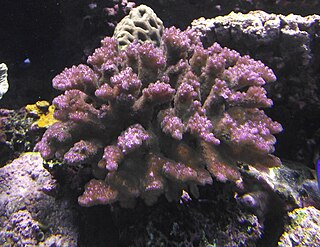
Pocillopora verrucosa, commonly known as cauliflower coral, rasp coral, or knob-horned coral, is a species of stony coral in the family Pocilloporidae. It is native to tropical and subtropical parts of the Indian and Pacific Oceans.

Zelentia pustulata is a species of sea slug, an aeolid nudibranch, a marine gastropod mollusc in the family Trinchesiidae.
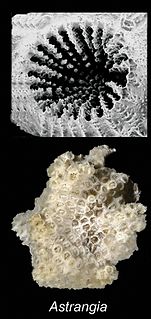
Astrangia poculata, the northern star coral or northern cup coral, is a species of non-reefbuilding stony coral in the family Rhizangiidae. It is native to shallow water in the western Atlantic Ocean and the Caribbean Sea. It is also found on the western coast of Africa. The International Union for Conservation of Nature lists this coral as being of "least concern". Astrangia poculata is an emerging model organism for corals because it harbors a facultative photosymbiosis, is a calcifying coral, and has a large geographic range. Research on this emerging model system is showcased annually by the Astrangia Research Working Group, collaboratively hosted by Roger Williams University, Boston University, and Southern Connecticut State University

Clathria prolifera, commonly known as red beard sponge, is a species of sea sponge in the family Microcionidae. It is native to shallow water habitats in the western Atlantic Ocean from Prince Edward Island southwards to Florida and Mexico, and possibly Brazil. In the twentieth century it also became established on the west coast of the United States.
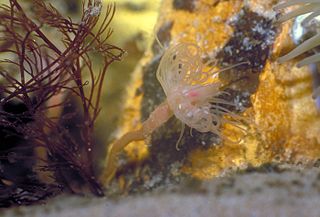
Ectopleura larynx, or ringed tubularia, is a hydroid in the family Tubulariidae.

Sertularella gayi is a branching colonial hydroid in the family Sertulariidae.
Corymorpha nutans is a hydroid in the family Corymorphidae.
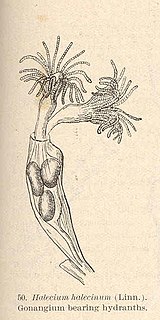
Halecium halecinum, commonly known as the herring-bone hydroid, is a species of hydrozoan in the family Haleciidae. It is native to the eastern Atlantic Ocean, the western Atlantic Ocean and the eastern Pacific Ocean.

Obelia dichotoma is a broadly distributed, mainly marine but sometimes freshwater, colonial hydrozoan in the order Leptothecata that forms regular branching stems and a distinctive hydrotheca. O. dichotoma can be found in climates from the arctic to the tropics in protected waters such as marches and creeks but not near open coasts like beaches in depths up to 250m. O. dichotoma uses asexual and sexual reproduction and feeds on mainly zooplankton and fecal pellets. Obelia dichotoma has a complex relationship with the ecosystem and many economic systems.


















